Difference between revisions of "Silica in Poaceae"
m (Spelling) |
|||
| Line 17: | Line 17: | ||
==Brachiaria== | ==Brachiaria== | ||
| − | Brachiaria species ('Signal grass') are C<sub>4</sub> ('Millet') grasses that grow fast.[http://link.springer.com/article/10.1007%2Fs11104-010-0472-5#page-2] ''Brachiaria brizantha'' may contain 1.38% silicon [http://www.biomedcentral.com/content/pdf/1754-6834-7-10.pdf] Brachiaria brizantha adapts poorly to poorly drained soils.[http://www.tropicalforages.info/key/Forages/Media/Html/Brachiaria_brizantha.htm] Particularly ''Brachiaria decumbens'' (aka Urochloa decumbens, aka Surinam grass / Signal grass) may be considered silicon accumulating (3.6% in adult leaves[http://www.abz.org.br/files.php?file=documentos/R1172_1_630921223.pdf]) and resistant to droughts.[http://www.scielo.br/scielo.php?pid=S0103-90162003000400022&script=sci_arttext] It occurs in Burundi, Rwanda, Democratic Republic of Congo, Kenia, Tanzania and Uganda.[http://grassworld.myspecies.info/sites/grassworld.myspecies.info/files/UV_2.pdf] Silica levels in Brachiaria decumbens are highest in mature leaves, particularly on the upper epidermis of the grass leaf blades.[http://connection.ebscohost.com/c/articles/54568182/silicon-distribution-accumulation-shoot-tissue-tropical-forage-grass-brachiaria-brizantha] | + | Brachiaria species ('Signal grass') are C<sub>4</sub> ('Millet') grasses that grow fast.[http://link.springer.com/article/10.1007%2Fs11104-010-0472-5#page-2] ''Brachiaria brizantha'' may contain 1.38% silicon [http://www.biomedcentral.com/content/pdf/1754-6834-7-10.pdf] Brachiaria brizantha adapts poorly to poorly drained soils.[http://www.tropicalforages.info/key/Forages/Media/Html/Brachiaria_brizantha.htm] |
| + | |||
| + | Particularly ''Brachiaria decumbens'' (aka Urochloa decumbens, aka Surinam grass / Signal grass) may be considered silicon accumulating (3.6% in adult leaves[http://www.abz.org.br/files.php?file=documentos/R1172_1_630921223.pdf]) and resistant to droughts.[http://www.scielo.br/scielo.php?pid=S0103-90162003000400022&script=sci_arttext] It occurs in Burundi, Rwanda, Democratic Republic of Congo, Kenia, Tanzania and Uganda.[http://grassworld.myspecies.info/sites/grassworld.myspecies.info/files/UV_2.pdf] Silica levels in Brachiaria decumbens are highest in mature leaves, particularly on the upper epidermis of the grass leaf blades.[http://connection.ebscohost.com/c/articles/54568182/silicon-distribution-accumulation-shoot-tissue-tropical-forage-grass-brachiaria-brizantha] | ||
| + | It may also grow in low fertilitiy, low pH (as low as pH 3.5) soil, while it does not respond to lime, but responds strongly to N and P fertiliser. | ||
| + | It cannot persist on heavy clays subject to waterlogging, as its root system is very fine with low tolerance of poor drainage. Brachiaria decumbens stays green well into the dry season. It is most productive on open grasslands in the lowland humid tropics with rainfall >1,500 mm annually and a dry season of up to 5 months. It can tolerate short-term flooding and prefers temperatures above 19ºC. It is very tolerant of heavy grazing but less tolerant under reduced light than in full sun.[http://www.tropicalforages.info/key/Forages/Media/Html/Brachiaria_decumbens.htm] | ||
==Panicum== | ==Panicum== | ||
| Line 25: | Line 29: | ||
==Other Poaceae== | ==Other Poaceae== | ||
| − | Besides grasses, ''Pleioblastus chino'' 5.1% (a bamboo species) may contain 5.1% silica, ''Marchantia polymorpha'' (common liverwort or umbrella liverwort) may contain 5.5%, ''Eleocharis uniglumis'' (spikesedges in aquatic or mesic habitats) 6.7% and Arundinaria gigantea ( | + | Besides grasses, ''Pleioblastus chino'' 5.1% (a bamboo species) may contain 5.1% silica, ''Marchantia polymorpha'' (common liverwort or umbrella liverwort) may contain 5.5%, ''Eleocharis uniglumis'' (spikesedges in aquatic or mesic habitats) 6.7% and Arundinaria gigantea (also a bamboo species) 8.8% [http://aob.oxfordjournals.org/content/96/6/1027/T1.expansion.html] Wetland Gramineae may accumulate up to 15% dry weight silica.[http://www.ncbi.nlm.nih.gov/pubmed/15012222/] |
==Arundinaria gigantea== | ==Arundinaria gigantea== | ||
| − | ''Arundinaria gigantea'' (aka | + | ''Arundinaria gigantea'' (aka Giant cane or River cane). ''Arundinaria gigantea var. tecta'' or ''Arundinaria tecta'' (Switch cane) is smaller and adapted to more aquatic conditions. [http://herbarium.usu.edu/webmanual/info2.asp?name=Arundinaria_gigantea&type=treatment] |
Revision as of 21:51, 1 December 2014
Contents
Silicon for algae
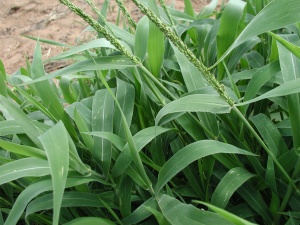

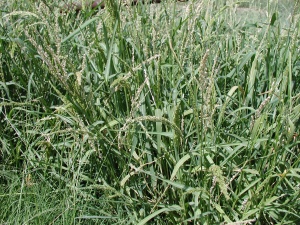
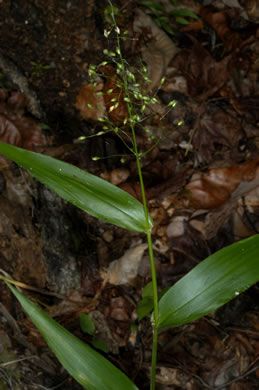
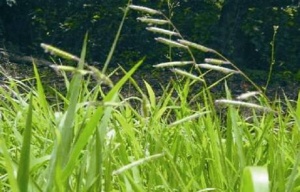
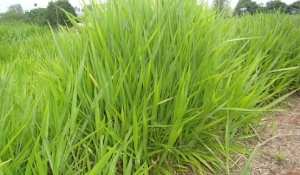
Tilapia naturally thrive on diatoms and Spirulina, which are algae. Diatoms that thrive in saline, alkaline conditions generally require high silicon:phosphorus ratios, including Anomoeoneis sphaerophora, Rhopalodia species, Nitzschia species and Synedra ulna. Compost may be used for supplying nutrients for the cultivation of Spirulina and diatoms. Compost may be derived from composting toilets. Such composting toilets frequently need the addition of dried plant material (sawdust, dried grasses or -leaves) as a carbon source. To add silicon along with the carbon, that plant material should be silicon accumulating. Silicon is the second most abundant element in soil.
Silica in plants
Plants may take up silicon from the soil if the pH is below 9. Biogenic silica is known to alleviate plant stressors such as high temperatures and drought.[7] There may be no relationship between soil type and plant Si concentrations, but with temperature and precipitation.[8] Leaf silica concentration in tall grass species increases with watering [9] and with age.[10] Blade silica content is higher after the grass has been defoliated.[11]
Grasses
Wheat (Triticum spp.) are grass species and may contain 0.3 to 10% silicon.[12] Triticum aestivum may contain 2.5%, Triticum boeoticum 2.5%, Triticum dicoccoides 1.2% and Triticum percicumx 1.6% silica. Rice (Oryza sativa) may contain 4.2% silica. [13] Pennisetum purpureum (Elephant grass) may contain 0.85% silica [14]
Brachiaria
Brachiaria species ('Signal grass') are C4 ('Millet') grasses that grow fast.[15] Brachiaria brizantha may contain 1.38% silicon [16] Brachiaria brizantha adapts poorly to poorly drained soils.[17]
Particularly Brachiaria decumbens (aka Urochloa decumbens, aka Surinam grass / Signal grass) may be considered silicon accumulating (3.6% in adult leaves[18]) and resistant to droughts.[19] It occurs in Burundi, Rwanda, Democratic Republic of Congo, Kenia, Tanzania and Uganda.[20] Silica levels in Brachiaria decumbens are highest in mature leaves, particularly on the upper epidermis of the grass leaf blades.[21] It may also grow in low fertilitiy, low pH (as low as pH 3.5) soil, while it does not respond to lime, but responds strongly to N and P fertiliser. It cannot persist on heavy clays subject to waterlogging, as its root system is very fine with low tolerance of poor drainage. Brachiaria decumbens stays green well into the dry season. It is most productive on open grasslands in the lowland humid tropics with rainfall >1,500 mm annually and a dry season of up to 5 months. It can tolerate short-term flooding and prefers temperatures above 19ºC. It is very tolerant of heavy grazing but less tolerant under reduced light than in full sun.[22]
Panicum
Panicum species ('Panic grass') are large tropical ('millet') grasses. Panicum maximum ('Buffalo grass') may contain 1.07% [23] or 0.5% silica.[24] Panicum virgatum ('Switch grass') may contain 1.5% [25] or 2.0% silica. Panicum commutatum may contain 4.2% and Panicum texanum may contain 8.0% silica [26] or 7%.[27] Panicum texanum (aka Brachiaria texana or Urochloa texana, aka Buffalo grass, Colorado grass, Texas signal grass or Texas millet) has up 2 cm wide leaves (7.5-28 cm long) that are covered with soft minute hairs on both surfaces. Its stems may be up to 136 cm long, and the grass may grow 80 cm high.[28] It is a common troublesome weed in many commercial crops. It may grow well at 30°C during the day and 24°C during the night. It may produce 53,000 seeds per plant.[29] (and therefore used by bird-enthusiasts[30]) It grows along streams, in open fields, on prairies and on deep moist soils, southern USA and Mexico. Both annual and perennial. It is used for hay.[31] It is best adapted to well-drained sandy soils, and usually produces 23,000 seeds per plant.[32] Vegetative stage Panicum texanum may contain 16% crude protein. It may contain 11% crude protein at flower/boot stage and 8% crude protein at fruit/head stage. Subsequent invitro dry matter digestibility may range from 74 to 52%.[33] Panicum texanum occurs in Queensland and New South Wales (Australia), Arizona, California. New Mexico, Texas. Alabama, Arkansas, Florida, Georgia, Louisiana and South Carolina (USA) and North-east Zacatecas (Mexico).[34]
Other Poaceae
Besides grasses, Pleioblastus chino 5.1% (a bamboo species) may contain 5.1% silica, Marchantia polymorpha (common liverwort or umbrella liverwort) may contain 5.5%, Eleocharis uniglumis (spikesedges in aquatic or mesic habitats) 6.7% and Arundinaria gigantea (also a bamboo species) 8.8% [35] Wetland Gramineae may accumulate up to 15% dry weight silica.[36]
Arundinaria gigantea
Arundinaria gigantea (aka Giant cane or River cane). Arundinaria gigantea var. tecta or Arundinaria tecta (Switch cane) is smaller and adapted to more aquatic conditions. [37]